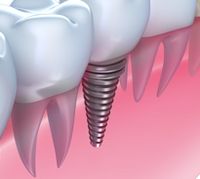A Brief Guide to Immediate Dental Implants

Dental implants offer a modern solution for missing or severely damaged teeth. In the past, to place an implant, a dentist would first remove any remaining bits of tooth and clean the socket and allow a minimum 3 months of healing. A tiny titanium post was then screwed into the jawbone and another 3 – 4 months of healing was required. Once the implant healed to the bone, a fake tooth was mounted onto this post in the restorative phase. This procedure would require a minimum of 6 months before a tooth could even be placed. Today so-called “immediate” implants allow you to get the replacement tooth much more quickly.
FAQs About Immediate Dental Implants
How Fast Can They Be Installed?
 The waiting period between a tooth extraction and dental implant placement used to run three to four months on average. In select cases, the “immediate” implant option allows patients to have the implant placed at the time of extraction, one appointment.
The waiting period between a tooth extraction and dental implant placement used to run three to four months on average. In select cases, the “immediate” implant option allows patients to have the implant placed at the time of extraction, one appointment.
Efficiency Aside, Are There Other Benefits?
In the anterior esthetic zone, it is much easier to maintain soft tissue contours for a better esthetic outcome. In the conventional way, we would allow the tissue to heal over the implant. It would then require “training of the tissue” to reshape the tissue contours. This often took 6 months or more to achieve a good esthetic result.
As a socket heals the bone actually resorbs or “melts away.” Placing the implant immediately does not compensate for this bone loss but may allow for a simpler less expensive type of bone graft.
What Is the Recovery Process Like?
Your dentist will provide precise post-op instructions. In general, you’ll be advised to not bite down on the newly implanted fixture for a couple months. Accidentally biting down on the implant will likely cause it to fail. You can expect some discomfort and swelling for a few days. The discomfort is no different than having a tooth removed. This is usually easily managed with analgesics, prescribed or over the counter medications.
Is the Procedure Painful?
The procedure is no different than having a tooth removed. Once the local anesthesia takes effect, a pressure sensation is all you should feel. Other forms of sedation may be available which you can discuss with your oral and maxillofacial surgeon.
Are Immediate Implants Safe?
Yes. Your dentist will ensure that you are a candidate for an immediate implant and plan the procedure in advance using modern X-ray or CT scan technology. Make sure you seek the help of qualified professional with experience in placing immediate implants.
If the tooth is removed atraumatically and implant stability is achieved, the success rate is no different than proceeding in the conventional, delayed placement manner.
Success rates in the low to mid 90% range are commonplace with immediate implant placement in the properly selected case.
Want to know more about immediate dental implants? Talk to Lyle C.Yanagihara, DDS, MS, in Honolulu, HI. This oral surgeon uses cutting-edge technology to give patients more beautiful smiles. They will put your comfort first and answer any questions you might have. To schedule an appointment, use their online contact form or call (808) 973-1433.
About the Business
Have a question? Ask the experts!
Send your question

